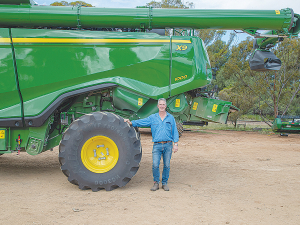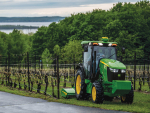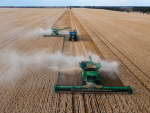Mother Nature always has a part to play at harvest, so after intermittent showers on already wet fields made it a challenging period at Crystal Brook, in South Australia’s Mid North, David Hosking was keen to see how quickly his new John Deere X9 1000 combine harvester could get through the workload.
“On one decent hot day on the X9, we harvested nearly 600t of wheat over a 12-hour period, with two of us delivering nine or ten road trains for the day,” Hosking said from his base at Narridy.
“It was so wet in September, October, and November that the water was still running out of the ground, and a late start meant we finished harvest a month later than usual.
“But despite the 2022 cropping year being bookended by a dry start and a wet and windy finish, it was a good harvest, and one where the X9 proved its worth in the paddock.”
The Hoskings’ drysown crops - 550ha of bread wheat, 210ha of durum, 790ha barley, 100ha of faba beans and 1150ha of lentils, recorded above average yields.
“We averaged over five tonnes per ha for wheat and over three tonnes per ha on the lentils. Overall, we put as much grain through the X9 Harvester in one harvest as we have in the past two-and-ahalf years, thanks to the good yields and expanded cropping area,” Hosking said.
After expanding land area under cropping to 2800ha in 2022, the Hosking family replaced their John Deere S680 and 45-foot front with the X9 Harvester featuring a 50-foot hinged draper front, to get their crop off and away quickly. The X Series machine effectively offered an extra half a header in power and capacity but in the same frame size as the S Series.
With weather conditions becoming more variable, the X Series is designed to optimise harvest windows and enable farmers to harvest quickly and with minimal grain loss. Hosking said the new machine handled a variety of operating conditions with ease, with the biggest surprise being fuel economy, during the 350 threshing hours.
“Although we were harvesting 60 to 70% more tonnes per hour than in the S680, we used the same amount of fuel.
“We’d expected to use 100L per hour, but averaged 80L per hour, across the campaign” he said. “Although we didn’t need to upgrade our fuel trailer, following a demo, we knew our chaser bin wouldn’t keep up, so we invested in a bigger bin, upgrading from 18 tonnes to 36 tonnes.”
Nervous about how the X9 Harvester’s hinged draper front would handle the challenge of some rocky conditions and the deep wheel ruts made in the wet, he was “very impressed” by its performance.
“It was far superior to anything we’ve ever harvested with or seen in cereals. The front tracked the ground very well and the draper system was able to feed in cereals very smoothly,” he said.
“We harvested a lot of lentils on the ground with wheel tracks which was challenging, but the number of settings was very good.
“The ability to change knife angles and downforce settings from the cabin, as opposed to getting out to do it manually, was useful and appreciated by the operators.”



















